
views
Preparing to Breed

Find out if it is legal to keep chickens in your area. Some places have strict laws on keeping chickens whilst other places has ruled on keeping roosters and the amount of chickens you have. To avoid a fine it is best to check your local laws and regulations in your area.
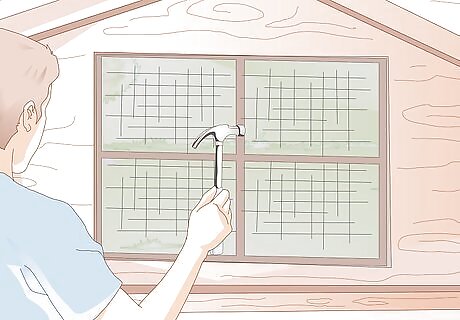
Make sure that you can house the new chickens. Many people don’t take into account that when you breed chickens, you will end up with significantly more chickens than you started with. Ensure that your chicken coop is ready for the new additions to your flock. Keep spare coops and equipment around so you're prepared to separate roosters or bullies of the flock. Sometimes you just won't have enough room to keep all chickens in one coop or you might get a few more roosters than hens that are aggressive towards each over.

Decide if you want to take a chance on more roosters. Breeding chickens will result in about 50% male chicks. Male chickens will not contribute to your egg production, eat larger amounts of food, and will significantly increase the noise level of your flock. Be aware that breeding chickens will always result in having to deal with roosters.
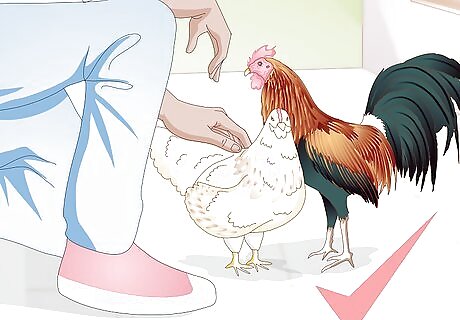
Obtain a rooster. In order to fertilize your hen’s eggs, you will need a rooster in prime breeding condition. The rooster does not need to be the same breed as your hens in order to mate. You should have 1 rooster for every 10 hens. Try to find a rooster from a good breeding stock. His eye color should be even, and his feet should be free from deformities. The rooster’s comb should look like a standard comb for his breed. Be prepared for noise. Roosters are loud animals, and many cities and suburban areas have laws against owning roosters due to the noise. Make sure that you can legally own a rooster. If you cannot, you will need to purchase fertilized eggs to hatch. Some breeds can be fairly aggressive. Make sure that you pick a rooster that is even-tempered, especially if you have children.

Start breeding in the spring. Although you can breed chickens throughout most of the year, chickens bred in the Spring tend to be stronger. Chickens born in the Spring will begin producing eggs in Autumn. You do not need to do anything special in order to breed your chickens, just introduce the rooster to your flock and let nature take its course. Make sure both your hens and your rooster are eating quality food. This will ensure that their reproductive systems are as strong as possible. If you are breeding second generation or third generation chickens, be very wary of inbreeding issues. Try to tag your chickens so that you know which ones are related to the rooster. You can keep the rooster separate and only allow in the hens that you want to breed. You may also consider getting a new rooster each year.

Decide between incubating the eggs yourself, or allowing the hen to raise her chicks. If you rely on your hens for egg-laying, letting the hen raise the egg will result in about 3 months of lost egg production (21 days to set and hatch her clutch, and another 2 months to raise her babies before she starts laying again). You will also need a “broody” hen, which means she is willing to sit on the egg for the entire incubation period. Most chickens have had the broody trait bred out to keep them productive. Some of the broodiest breeds include: Silkies, Serama, Brahma, Jersey Giant, New Hampshire Red, Sussex, and others. If you have a large number of eggs to incubate, or are incubating to sell, it may be worthwhile to invest in an incubator.
Choosing the Eggs to Incubate
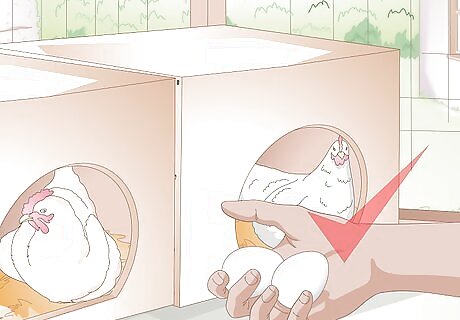
Collect your eggs regularly. Even if you are going to let the hens incubate the eggs, you will want to collect them and choose the best ones to incubate. Collect eggs two to three times a day to make sure that the eggs don’t get dirty or don’t start developing. If it starts getting hot out, collect eggs even more often than normal, up to five times a day. Use a soft basket to hold the eggs while you collect them. This will help keep them from getting damaged. A little straw in a hand basket makes for a perfect egg basket. Handle the eggs delicately to keep from upsetting the membrane and other internal parts. Clean your hands before gathering eggs. This will help prevent you passing on bacteria to the egg.
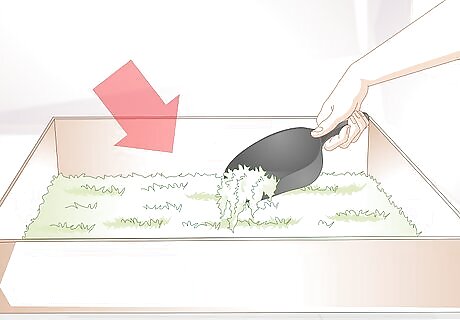
Keep the nest clean. Although you should always be keeping the coop and nest boxes clean, it is especially important when breeding. Mud and droppings can increase the amount of harmful bacteria that can infect the egg, which will hurt the egg’s chances. Make sure the hens always have clean bedding.

Choose the eggs you wish to incubate. Choosing the right eggs will significantly increase your chances of a successful hatch. You will want to avoid eggs that are noticeably larger or smaller. Large eggs have difficulty hatching, and small eggs often produce chicks that are too small to live. Do not choose any eggs that have been cracked. Also avoid eggs with thin shells. Do not choose eggs that are noticeably misshapen. Only keep the clean eggs. Washing or wiping dirty eggs removes protective coating, making it more vulnerable to bacteria.
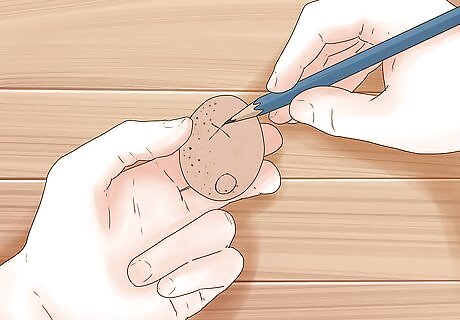
Mark your eggs. If you are hatching a lot of eggs, or are breeding different types of chickens, you may find it useful to mark the eggs with dates or breeds to help you keep track of them all. You can use a pencil, marking pen, or a stamp.
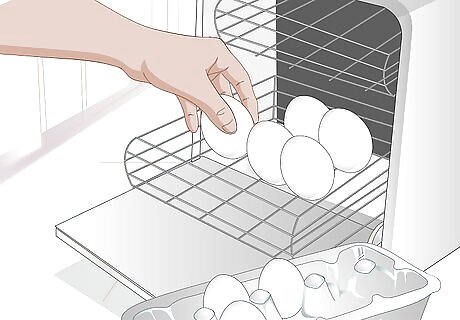
Store the eggs. Eggs can be stored up to 7 days after they have been laid and before you start incubating. Eggs should be stored for at least 24 hours before you start incubation, otherwise they may not hatch as well. Try to maintain a temperature of 55 °F (13 °C) and high humidity. Store the eggs with the pointy end down.

Turn the eggs daily. While you are storing the eggs, they will need to be turned once a day to keep the membrane from sticking to one side. You can do this by placing a piece of wood underneath one end of the carton and then switching it to the other end the next day.
Letting the Hen Hatch the Eggs
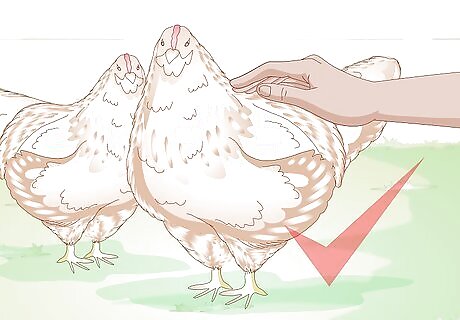
Find your broody hen. You can use fake eggs to test for hens that may be more broody than others. If your hen will sit on the fake eggs for 24 hours, then she will most likely successfully incubate eggs for 21 days.
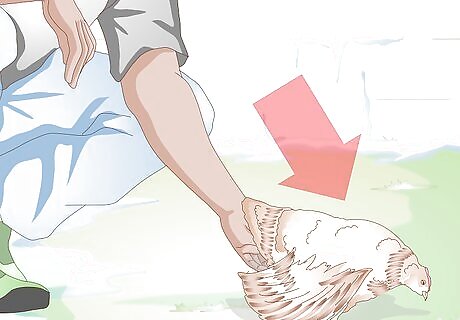
Sneak the eggs under the hen. This will be easiest at night, while the hen is sleeping. Depending on the breed, she may be able to incubate up to 12 eggs. Smaller breeds may only be able to fit 6 or so. All the eggs need to be able to be covered when she roosts.

Separate the brooding hen and her eggs from the other chickens. If you can, separate the new mother and her eggs from the rest of the flock to prevent them from getting dirty or damaged. If your hen is resistant to moving, then leave them where they are or move the hen and her nest overnight. Warning: Moving any hen while she is setting may cause her to abandon nest, so if these are expensive eggs, have a back up plan in place. If you can’t separate them, try to keep the other chickens from bothering the new mother as much as possible.
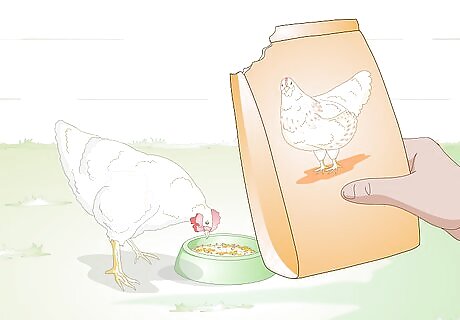
Keep the mother well fed. Make sure that the mother hen has plenty of fresh water and food. You can switch the hen to chick starter food so that the chicks have the correct food right away. The hen won’t eat as much as normal. Watch her and make sure that she is eating and drinking. You may have to remove her from the nest or set her a food and water dish right beside her nest. Hens will sometimes refuse to leave the nest to eat or drink and starve to death.
Let the hen hatch the eggs. When the eggs start hatching, don’t disturb the hen. She will help the chicks hatch. Eggs begin hatching around the 21st day, and the process can take up to 24 hours or more. Most of the eggs should hatch around the same time. After hatching has started, remove any unhatched eggs after about two days.
Let the mother raise the chicks. If you opted to have the eggs hatch naturally, the mother will provide all of the necessary warmth and care for the chicks, and you will not need to put them in a brooder.
Try to keep them separate. For the first six weeks, try to keep the chicks and the mother separate from the rest of your flock. This will allow them to get their bearings without being picked on by the other chickens. Provide a brooding area that the hen can enter and leave but the chicks can’t leave. This will help keep them out of trouble.
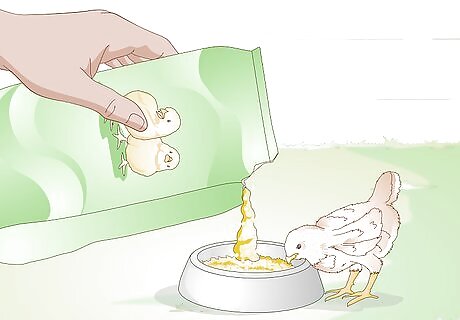
Provide plenty of clean water and fresh food. Chicks need specific blends of food to grow up healthy, so make sure that there is plenty available. Different feeds will recommend changing types after a certain amount of time (6 weeks, 3 months, etc.).
Introduce the chicks to the flock. After about 6 weeks, the chickens will be ready to be introduced to your flock. Introduce them slowly, and ensure that everyone is getting along before moving them in permanently. The mother hen will help keep other chickens in line during the transition process.
Incubating the Eggs Yourself

Obtain an incubator. You can build your own incubator, or you can buy one from a farm supply company. If you are buying one, make sure that it has easy to control temperature and humidity, as well as good egg-turning options. One of the biggest factors when choosing an incubator is the number of eggs you intend to hatch. Usually only about 50-70% of the eggs that you incubate will hatch, and then half of those will turn into roosters.

Set your incubator up in a temperature-controlled room. A stable room temperature will allow the incubator to keep a stable internal temperature much easier. Avoid placing the incubator next to a heater, or next to a window or door. You will need to check your incubator often, so make sure that you can access it easily.
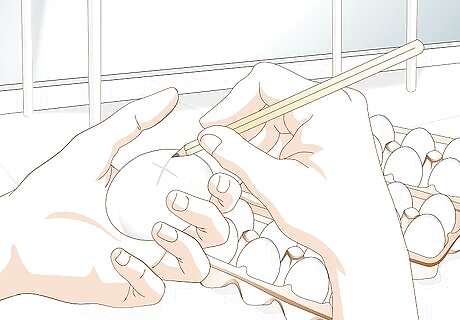
Mark your eggs if you haven’t already. If you didn’t mark your eggs when you collected them, you should mark them before putting them in the incubator. This will help you know if the egg has been turned or not.

Preheat your incubator. Allow the incubator to run for a few hours before placing the eggs in. This will allow the incubator to reach the heat and humidity it needs. If your incubator has fans it should maintain a constant temperature of 100 °F (38 °C). If it does not have fans, keep the temperature at 102 °F (39 °C). Humidity for the first 18 days should be around 40%.
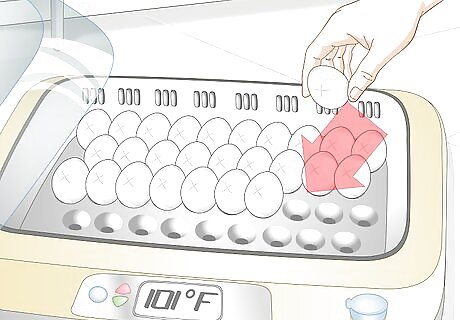
Place your eggs in the incubator. Eggs should always have the large end facing up, or be lying horizontally with the large end tilted up. The small end should never be facing up, or the eggs will not develop properly and chick will most likely die trying to hatch.
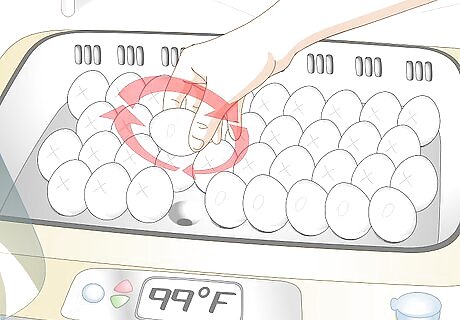
Turn the eggs. Eggs need to be turned around 5 times per day. Turn the eggs gently to avoid damaging the embryo. Do not turn the egg in the same direction each time. They do not get turned on the last 3 days before hatching.
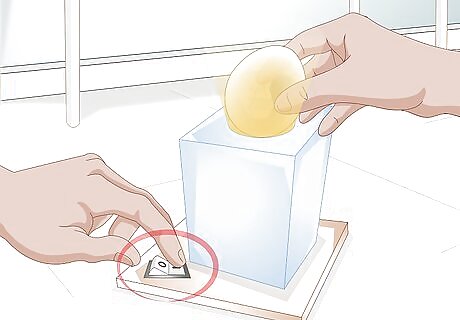
Candle your eggs. Candling eggs allows you to tell if embryos are actually growing inside or not. You will need a bright flashlight and a dark room to candle the eggs. Hold the egg with the large side upwards, and shine the flashlight through it. You should be able to see blood vessels beginning to develop, as well as the air sac on the top. You should be able to start seeing blood vessels after a few days of incubation. You should see a developed embryo after about 7 days. Throw away any undeveloped eggs between days 10 and 14. Humidity needs to be increased to 60-70% the last 3 days to prevent membranes from drying out. Do not open the incubator in the last 3 days.
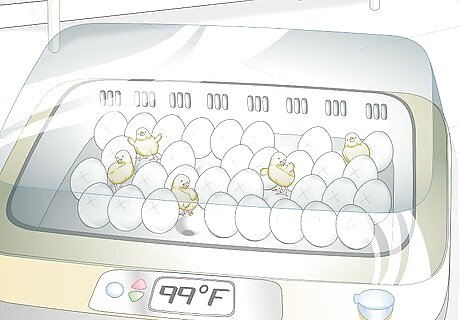
Allow the eggs to hatch. The hatching process can take the better part of a day. As soon as you notice pipping, increase the amount of oxygen that is entering the incubator by opening vents. The newly hatched chicks will not need to eat or drink for 48-72 hours, so allow the incubator to keep working as later chicks hatch. Avoid helping the chicks hatch. Chicks that cannot hatch on their own will most likely not survive into adulthood.
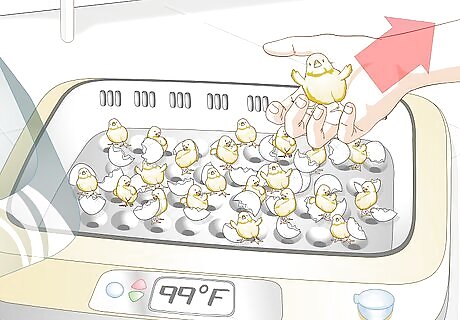
Move the chicks to a brooder. One the hatching process is complete and the chicks are dry, you can transfer the chicks to a brooder where they will be raised. You can either build your own brooder or purchase one from a farm supply store. A 40-watt bulb in a bedside lamp makes for a good source of heat. Use a red bulb to hide injuries so that the other chicks will not pester an injured one. The chicks need a temperature of 99 degrees F the 1st week, dropped by 5° each week until brooder temp is equal to outside temp or chicks are fully feathered. Keep the box in an area that is as draft-free as possible, and use wire to prevent cats from gaining access.
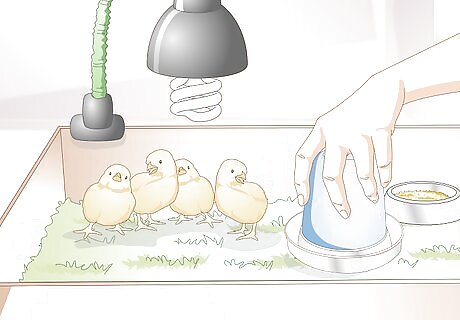
Keep a constant supply of fresh water and feed. Your chicks will need to always have an ample supply of food and water. Chicks need a specialized feed formulated for chicks. As they mature, they can graduate to standard chicken feed. Make sure water dishes are shallow, as chicks can easily drown in their own water dish. Add marbles to water to prevent drowning.
Introduce the chicks to the flock. After about 6 weeks, the chickens will be ready to be introduced to your flock. Introduce them slowly, and ensure that everyone is getting along before moving them in permanently.


















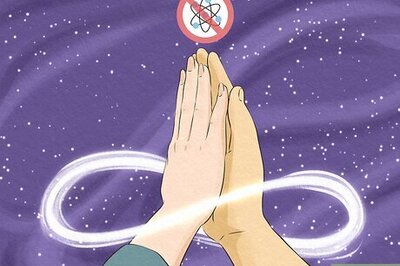
Comments
0 comment